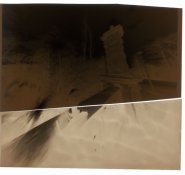Hi all,
I just today accidentally developed two Kodak Ektachrome 100G slides in D76 together with 3 sheets of TMax 400, as I thought they also were...
Despite also underexposing by two stops, as I presumed they were TMax as well when shooting, I DO see a visible image, and not to bad actually. I don't have to explain to you all it doesn't look like an "ordinary" slide . It sort of looks like a orange / green color negative. Fortunately, the TMax came out well, despite being intermingled...
. It sort of looks like a orange / green color negative. Fortunately, the TMax came out well, despite being intermingled...
However, although it's more of a theoretically question:
- Could these images be somehow printed, salvaged as ordinary BW negatives? (I noticed the visible silver image IS negative? if I am right?)
I guesse, since the slides are dark orange / green, pretty much like safe light filtration, ordinary printing on an enlarger is out the question. :confused:
Maybe I need to go the hybrid approach, scan and convert them to some sort of d***** neg using you-know-what?
Another question:
- Is such a D76, and normal BW developed, fixed and rinsed image actually "stable"? Or will it deteriorate due to the bad processing and some non-removed dyes / chemicals?
Thanks for responses.
Marco
I just today accidentally developed two Kodak Ektachrome 100G slides in D76 together with 3 sheets of TMax 400, as I thought they also were...
Despite also underexposing by two stops, as I presumed they were TMax as well when shooting, I DO see a visible image, and not to bad actually. I don't have to explain to you all it doesn't look like an "ordinary" slide
 . It sort of looks like a orange / green color negative. Fortunately, the TMax came out well, despite being intermingled...
. It sort of looks like a orange / green color negative. Fortunately, the TMax came out well, despite being intermingled...However, although it's more of a theoretically question:
- Could these images be somehow printed, salvaged as ordinary BW negatives? (I noticed the visible silver image IS negative? if I am right?)
I guesse, since the slides are dark orange / green, pretty much like safe light filtration, ordinary printing on an enlarger is out the question. :confused:
Maybe I need to go the hybrid approach, scan and convert them to some sort of d***** neg using you-know-what?
Another question:
- Is such a D76, and normal BW developed, fixed and rinsed image actually "stable"? Or will it deteriorate due to the bad processing and some non-removed dyes / chemicals?
Thanks for responses.
Marco


 .
.


